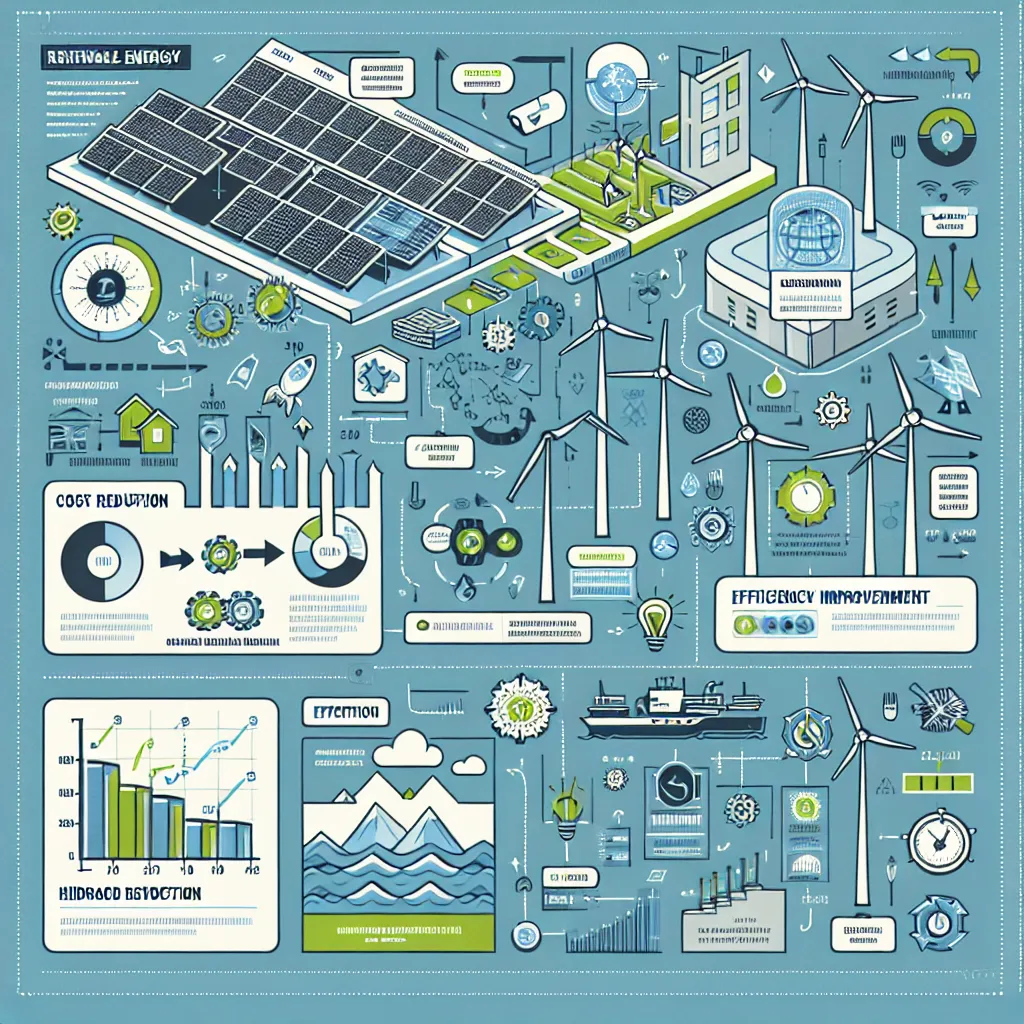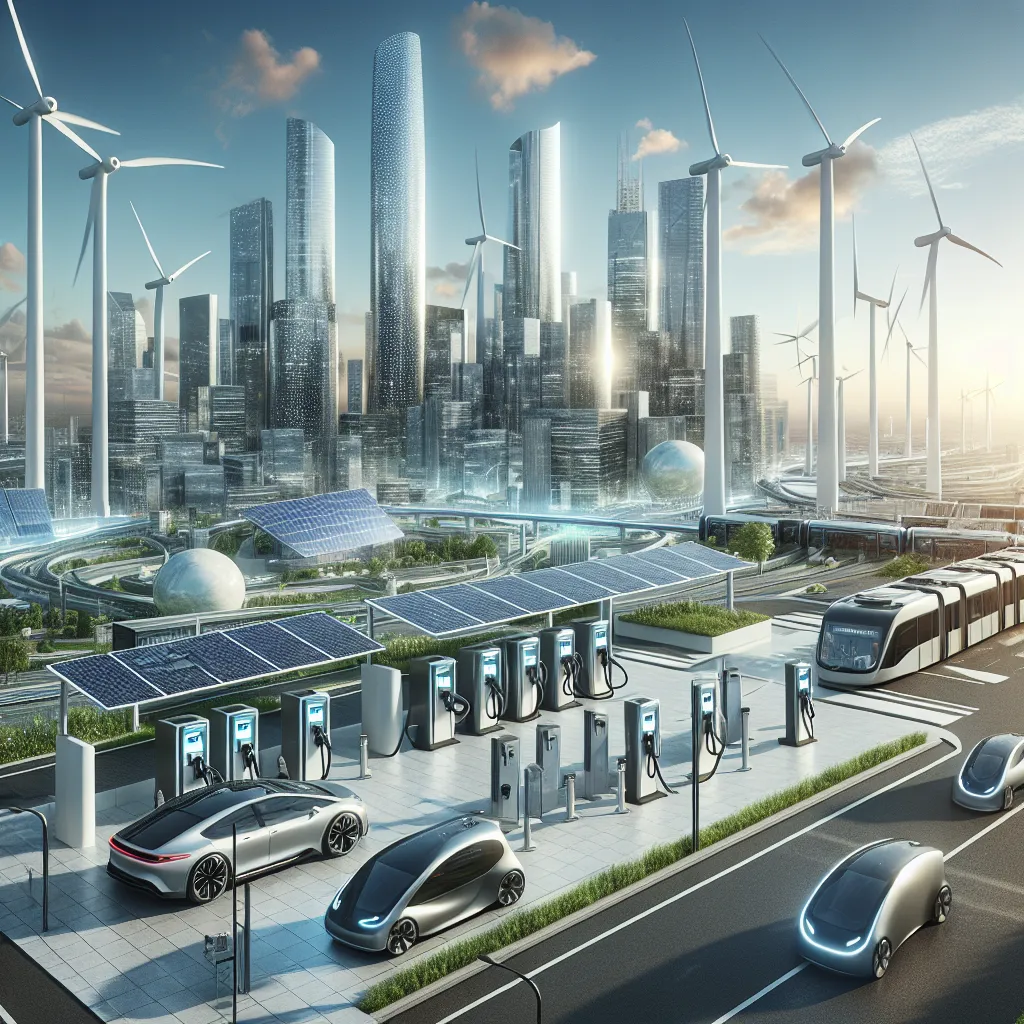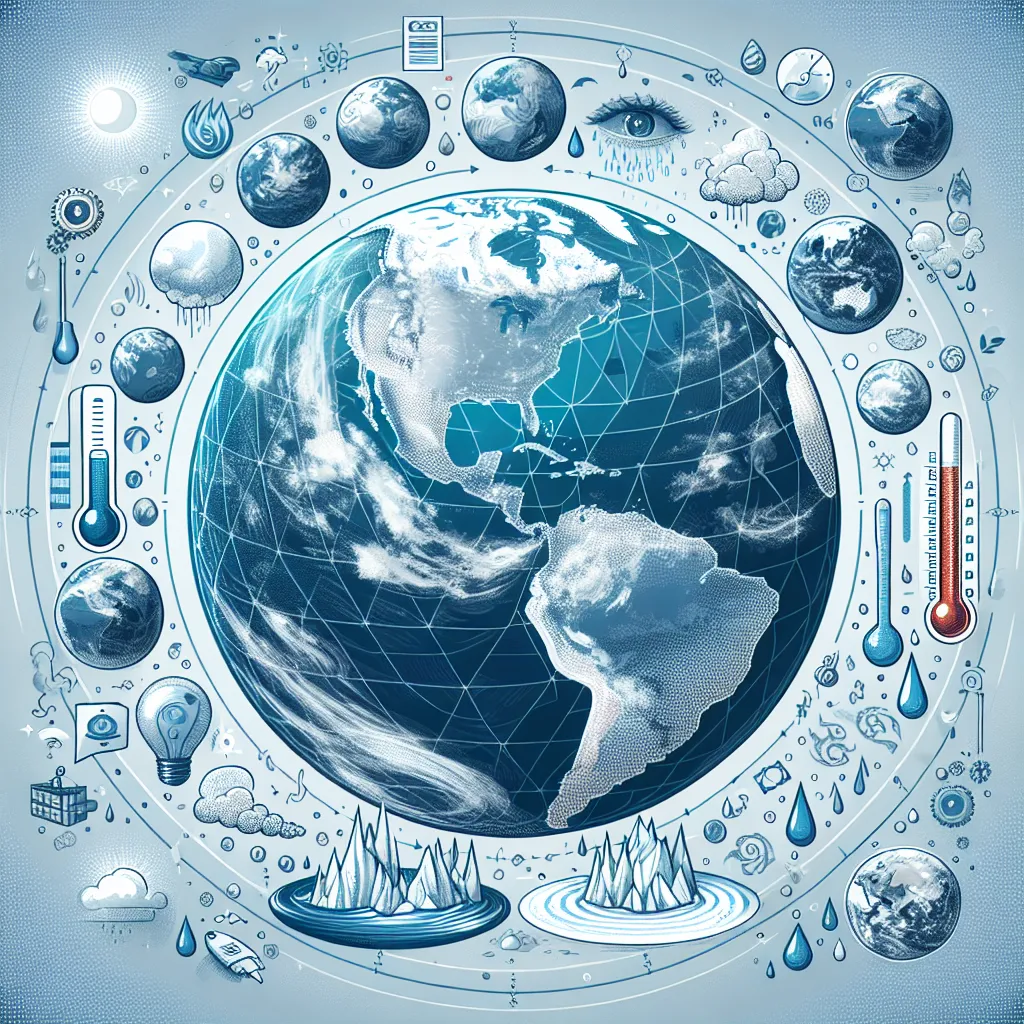As an experienced IELTS instructor, I’m excited to share a comprehensive reading practice focusing on the topic of renewable energy innovations and their impact on cost reduction. This practice will help you prepare for the IELTS Reading test while expanding your knowledge on this crucial subject.
Nội dung bài viết
- Introduction
- Reading Passages and Questions
- Passage 1 – Easy Text
- The Rise of Renewable Energy
- Questions 1-5
- Questions 6-10
- Passage 2 – Medium Text
- Innovations Driving Cost Reductions in Solar Energy
- Questions 11-14
- Questions 15-20
- Passage 3 – Hard Text
- The Synergistic Effect of Innovations on Wind Energy Costs
- Questions 21-26
- Questions 27-33
- Questions 34-40
- Answer Key
- Passage 1
- Passage 2
- Passage 3
- Conclusion
 Renewable energy innovations reducing costs
Renewable energy innovations reducing costs
Introduction
The IELTS Reading test assesses your ability to understand and analyze complex texts. Today, we’ll explore “How renewable energy innovations are reducing costs” through a series of passages and questions that mirror the actual IELTS exam format. This topic is not only relevant for your test preparation but also for understanding global energy trends.
Reading Passages and Questions
Passage 1 – Easy Text
The Rise of Renewable Energy
Renewable energy has become increasingly popular in recent years, driven by concerns over climate change and the need for sustainable energy sources. Solar, wind, and hydroelectric power are among the most common forms of renewable energy. These technologies have seen significant advancements, leading to improved efficiency and reduced costs.
One of the main factors contributing to cost reduction is the economies of scale. As more renewable energy projects are implemented worldwide, the production of components such as solar panels and wind turbines has increased dramatically. This increase in production has led to lower manufacturing costs and more competitive pricing for consumers.
Technological innovations have also played a crucial role in reducing the cost of renewable energy. For example, improvements in solar cell design have resulted in higher energy conversion rates, meaning that more electricity can be generated from the same amount of sunlight. Similarly, advancements in wind turbine technology have led to larger, more efficient turbines that can generate more power even in areas with lower wind speeds.
Governments and private companies have invested heavily in research and development for renewable energy technologies. This investment has accelerated the pace of innovation, leading to breakthroughs in energy storage solutions, which address one of the main challenges of renewable energy – its intermittent nature.
As a result of these factors, the cost of renewable energy has dropped significantly over the past decade. In many parts of the world, renewable energy is now cost-competitive with traditional fossil fuels, and in some cases, it is even cheaper. This trend is expected to continue, making renewable energy an increasingly attractive option for both developed and developing countries.
Questions 1-5
Do the following statements agree with the information given in the reading passage?
Write
TRUE if the statement agrees with the information
FALSE if the statement contradicts the information
NOT GIVEN if there is no information on this
- Renewable energy has become more popular due to environmental concerns and the need for sustainable energy.
- Solar, wind, and nuclear power are the most common forms of renewable energy.
- Economies of scale have contributed to the reduction in renewable energy costs.
- Technological innovations have had no impact on the efficiency of solar cells.
- Renewable energy is now cheaper than fossil fuels in all parts of the world.
Questions 6-10
Complete the sentences below.
Choose NO MORE THAN TWO WORDS from the passage for each answer.
- Improvements in solar cell design have led to higher __ __ rates.
- Advancements in wind turbine technology have resulted in more efficient turbines that can generate more power even in areas with __ __ __.
- Heavy investment in research and development has come from both __ and private companies.
- One of the main challenges of renewable energy is its __ nature.
- The cost of renewable energy has dropped significantly over the past __.
Passage 2 – Medium Text
Innovations Driving Cost Reductions in Solar Energy
The solar energy sector has witnessed remarkable progress in recent years, with innovations across the entire value chain contributing to significant cost reductions. From improvements in photovoltaic (PV) cell efficiency to advancements in manufacturing processes, these developments have collectively propelled solar energy towards grid parity in many regions.
One of the most impactful innovations has been the development of high-efficiency solar cells. Traditional silicon-based cells have seen steady improvements, but new technologies such as perovskite solar cells have shown tremendous potential. Perovskite cells can be manufactured using simpler and less energy-intensive processes, potentially reducing production costs. Moreover, their efficiency has rapidly increased from about 3% in 2009 to over 25% in recent laboratory tests, rivaling the best silicon cells.
Bifacial solar panels represent another significant advancement. These panels can capture sunlight from both sides, increasing energy yield by up to 30% compared to traditional monofacial panels. This innovation effectively reduces the cost per watt of solar energy, as more power can be generated from the same panel footprint.
In the realm of manufacturing, automation and Industry 4.0 technologies have streamlined production processes, reducing labor costs and improving quality control. Advanced robotics and artificial intelligence are now employed in various stages of solar panel production, from cell fabrication to module assembly. These technologies not only increase production speed but also minimize defects, leading to higher-quality products at lower costs.
Economies of scale have played a crucial role in driving down solar energy costs. As global demand for solar panels has surged, manufacturers have been able to increase production volumes significantly. This scaling up has led to more efficient use of resources, better negotiating power for raw materials, and the ability to spread fixed costs over a larger number of units, all contributing to lower per-unit costs.
The development of more efficient inverters has also contributed to cost reductions in solar energy systems. Inverters, which convert the DC electricity produced by solar panels into AC electricity used in homes and businesses, have become more reliable and efficient. Micro-inverters and power optimizers have emerged as alternatives to traditional string inverters, offering improved performance, especially in shaded or complex roof configurations.
Innovative financing models have made solar energy more accessible to a broader range of consumers and businesses. Power Purchase Agreements (PPAs) and solar leasing options allow customers to install solar systems with little to no upfront cost, paying for the electricity generated over time. These models have significantly expanded the market for solar energy, driving further economies of scale and cost reductions.
Soft costs, which include permitting, inspection, and customer acquisition, have been a focus area for cost reduction efforts. Streamlined permitting processes and online platforms for solar design and quotation have helped reduce these non-hardware costs, which can account for a significant portion of the total system cost, especially in residential installations.
As these innovations continue to evolve and new technologies emerge, the cost of solar energy is expected to decline further. This ongoing reduction in costs, coupled with increasing concerns about climate change, positions solar energy as a key player in the global transition to renewable energy sources.
Questions 11-14
Choose the correct letter, A, B, C, or D.
-
According to the passage, which of the following is NOT mentioned as a factor contributing to cost reductions in solar energy?
A) Improvements in solar cell efficiency
B) Advancements in manufacturing processes
C) Government subsidies
D) Development of bifacial solar panels -
Perovskite solar cells are described as:
A) Less efficient than traditional silicon cells
B) More expensive to produce than silicon cells
C) Potentially cheaper to manufacture than silicon cells
D) Incapable of rivaling the efficiency of silicon cells -
The passage suggests that automation in solar panel production:
A) Increases labor costs
B) Reduces production speed
C) Improves quality control
D) Has no effect on product quality -
Which of the following is described as an alternative to traditional string inverters?
A) Bifacial solar panels
B) Micro-inverters
C) Perovskite cells
D) Power Purchase Agreements
Questions 15-20
Complete the summary below.
Choose NO MORE THAN TWO WORDS from the passage for each answer.
Innovations in solar energy have led to significant cost reductions. High-efficiency solar cells, including 15)__ cells, have shown great potential. 16)__ solar panels can increase energy yield by capturing sunlight from both sides. In manufacturing, 17)__ and Industry 4.0 technologies have improved production processes. 18)__ have allowed manufacturers to increase production volumes and reduce costs. 19)__ have become more efficient, contributing to overall system cost reductions. Finally, 20)__ costs, such as permitting and customer acquisition, have been reduced through streamlined processes and online platforms.
Passage 3 – Hard Text
The Synergistic Effect of Innovations on Wind Energy Costs
The wind energy sector has undergone a remarkable transformation over the past few decades, with a confluence of innovations driving substantial cost reductions. These advancements span various domains, including turbine design, materials science, grid integration, and operational efficiency. The synergistic effect of these innovations has propelled wind energy to become one of the most cost-competitive sources of electricity in many regions globally.
A pivotal development in wind energy technology has been the dramatic increase in turbine size. The square-cube law dictates that as the rotor diameter increases, the power output grows cubically while the cost increases quadratically. This principle has driven the industry towards ever-larger turbines, with modern offshore wind turbines boasting rotor diameters exceeding 220 meters. These colossal machines can generate over 14 megawatts of power, significantly reducing the levelized cost of energy (LCOE) through increased energy capture and reduced per-unit installation and maintenance costs.
Concomitant with the increase in turbine size has been the development of more sophisticated blade designs. Advanced aerodynamics, inspired by biomimicry and computational fluid dynamics, have led to blades that are not only more efficient at capturing wind energy but also more resilient to varying wind conditions. Variable-pitch systems allow blades to adjust their angle in real-time, optimizing energy capture across a wider range of wind speeds and reducing mechanical stress during high-wind events.
Materials science has played a crucial role in enabling these design advancements. The use of carbon fiber composites and hybrid materials has allowed for longer, stronger, and lighter blades. These materials offer superior strength-to-weight ratios compared to traditional fiberglass, enabling the construction of larger rotors without a proportional increase in weight. Additionally, nanotechnology has been employed to develop coatings that enhance blade durability, reduce ice formation, and minimize leading-edge erosion, thereby extending turbine lifespan and reducing maintenance costs.
The integration of smart sensors and Internet of Things (IoT) technologies has revolutionized wind farm operations and maintenance. Advanced monitoring systems can predict component failures before they occur, allowing for preemptive maintenance and minimizing downtime. Machine learning algorithms analyze vast amounts of data from these sensors, optimizing turbine performance in real-time and improving overall farm efficiency. This predictive maintenance approach has significantly reduced operational costs and increased turbine availability.
Grid integration technologies have addressed one of the primary challenges of wind energy: its intermittent nature. Advanced forecasting models, leveraging artificial intelligence and big data analytics, have dramatically improved the accuracy of wind power predictions. This enhanced predictability has reduced the need for expensive backup power and allowed for better integration of wind energy into existing grid systems. Furthermore, the development of high-voltage direct current (HVDC) transmission systems has enabled the efficient transport of wind-generated electricity over long distances, connecting remote, high-wind areas to population centers.
Floating offshore wind platforms represent a frontier in wind energy innovation, potentially unlocking vast wind resources in deep-water areas previously inaccessible to fixed-bottom turbines. These platforms, adapted from oil and gas industry technologies, allow for the deployment of wind farms in waters exceeding 60 meters in depth. While still in the early stages of commercial deployment, floating wind technology promises to significantly expand the global potential for offshore wind energy, potentially driving further cost reductions through increased scale and improved site selection.
The learning curve effect has been a fundamental driver of cost reductions in wind energy. As global installed capacity has grown, manufacturers and developers have gained valuable experience, optimizing processes, and reducing inefficiencies. This accumulated knowledge has led to faster installation times, improved project management, and more efficient supply chains, all contributing to lower costs.
Economies of scale have also played a significant role in cost reduction. The growth of the wind energy market has allowed for larger production runs of turbines and components, reducing per-unit costs. Moreover, as wind farms have increased in size, fixed costs such as grid connections and project development can be spread over a larger number of megawatts, further driving down the LCOE.
The policy landscape has been instrumental in fostering these innovations and driving cost reductions. Long-term, stable policy frameworks have provided the certainty needed for significant research and development investments. Competitive auction systems for renewable energy projects have incentivized cost reductions, with developers continually striving to offer lower prices to secure contracts.
As wind energy technology continues to evolve, new frontiers of innovation are emerging. Airborne wind energy systems, which aim to harness high-altitude winds using tethered kites or drones, represent a potentially disruptive technology. Vertical-axis wind turbines are being revisited for their potential in urban environments and areas with complex wind patterns. These and other nascent technologies may unlock further cost reductions and expand the applicability of wind energy.
The remarkable cost reductions achieved in wind energy over the past decades are a testament to the power of sustained innovation and scale. As the industry continues to evolve, addressing challenges such as recycling of turbine blades and minimizing environmental impacts, wind energy is poised to play an increasingly significant role in the global transition to a low-carbon energy system.
Questions 21-26
Complete the summary below.
Choose NO MORE THAN THREE WORDS from the passage for each answer.
The wind energy sector has seen significant cost reductions due to various innovations. One key development has been the 21)__ in turbine size, which follows the 22)__, resulting in more power output relative to cost. Advanced 23)__ have improved energy capture efficiency, while 24)__ allow blades to adjust to different wind conditions. 25)__ have enabled the construction of larger, lighter blades. The integration of 26)__ has revolutionized wind farm operations and maintenance, predicting component failures and optimizing performance.
Questions 27-33
Do the following statements agree with the information given in the reading passage?
Write
TRUE if the statement agrees with the information
FALSE if the statement contradicts the information
NOT GIVEN if there is no information on this
- Modern offshore wind turbines can generate over 14 megawatts of power.
- Variable-pitch systems in wind turbines can only operate effectively in low wind speeds.
- Nanotechnology has been used to develop coatings that enhance blade durability and reduce ice formation.
- Machine learning algorithms have had no significant impact on wind farm efficiency.
- Floating offshore wind platforms can be deployed in waters less than 30 meters deep.
- The learning curve effect has led to faster installation times and more efficient supply chains in the wind energy sector.
- Airborne wind energy systems are already widely used in commercial wind farms.
Questions 34-40
Complete the sentences below.
Choose NO MORE THAN TWO WORDS from the passage for each answer.
- Advanced forecasting models have improved the __ of wind power predictions.
- __ transmission systems have enabled efficient transport of wind-generated electricity over long distances.
- Floating wind technology has the potential to expand the global __ for offshore wind energy.
- The growth of the wind energy market has allowed for larger production runs, leading to __ of scale.
- __ frameworks have provided the certainty needed for significant research and development investments.
- __ systems for renewable energy projects have incentivized cost reductions.
- __ wind turbines are being reconsidered for use in urban environments and areas with complex wind patterns.
Answer Key
Passage 1
- TRUE
- FALSE
- TRUE
- FALSE
- FALSE
- energy conversion
- lower wind speeds
- governments
- intermittent
- decade
Passage 2
- C
- C
- C
- B
- perovskite
- Bifacial
- automation
- Economies of scale
- Inverters
- Soft
Passage 3
- dramatic increase
- square-cube law
- blade designs
- Variable-pitch systems
- carbon fiber composites
- smart sensors
- TRUE
- FALSE
- TRUE
- FALSE
- FALSE
- TRUE
- FALSE
- accuracy
- High-voltage direct current
- potential
- economies
- Long-term, stable policy
- Competitive auction
- Vertical-axis
Conclusion
This IELTS Reading practice on renewable energy innovations and cost reduction provides valuable insights into the latest developments in the field while helping you prepare for the exam. Remember to practice regularly and familiarize yourself with various question types to improve your performance.
For more information on related topics, check out our articles on the impact of renewable energy on rural electrification and how renewable energy is transforming agriculture. These resources will help


